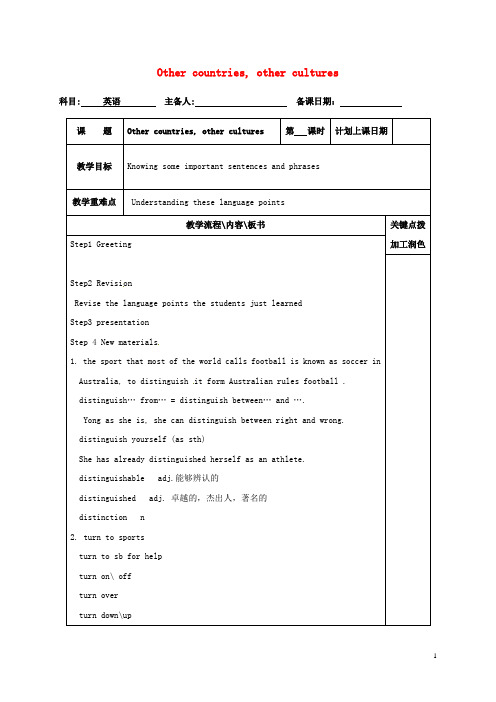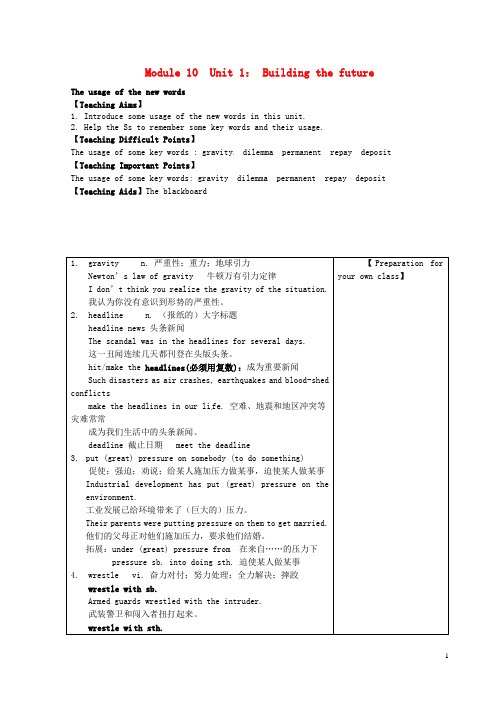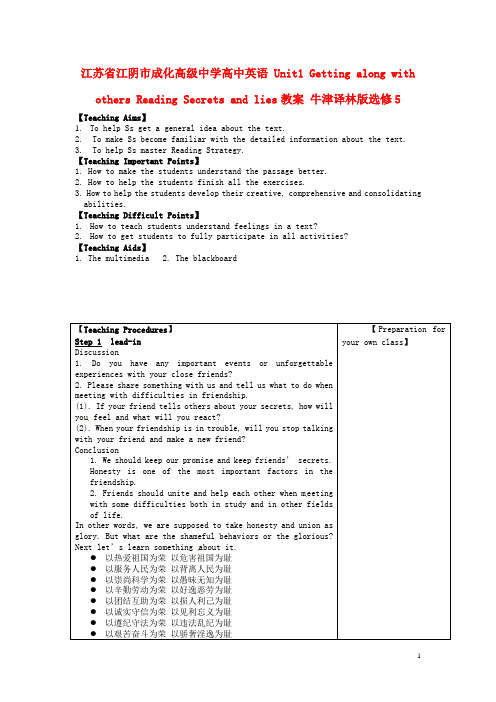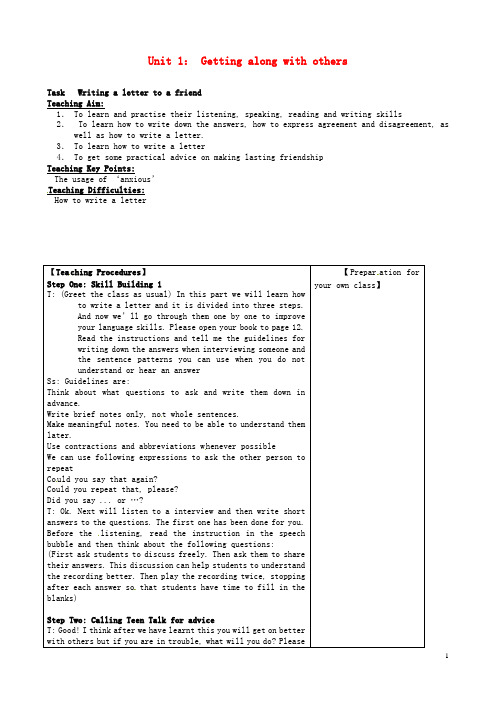江苏省江阴市成化高级中学高中英语 Unit1 Other countries,other cultu
- 格式:doc
- 大小:90.01 KB
- 文档页数:3




江苏省江阴市成化高级中学高中英语 Unit1 Getting along with others Project学案牛津译林版选修5【预习案】1.根据所给中文提示,在书本中划出相关词汇(在末页)2.预习《伴你学》P19-20的“自主研学”部分【新课案】重点词汇与句型18..hesitate vi. 踌躇;犹豫;迟疑 n.犹豫I succeeded because I never hesitated. ---- Napoleon我成功是因为我有决心,从不踌躇。
---- 拿破仑(1)If you need any help, please don’t hesitate (ask).(2) She agreed . 她毫不犹豫地同意了。
19.mean v. P PP.(1) I mean (help) you, but I am quite busy.(2) Missing the bus means (wait) for an hour.(3) This p lan (旨在保护我们的环境).(4)Every possible means_ _ (use) to prevent air pollution, but the sky is still not clear.(5) All possible means_ _ (use) to prevent air pollution, but the sky is still not clear.20. respond vi. n. adj.响应,回答,对…做出反应 /以微笑作为回答对…做出很快的反应对…负责(1)当我和他打招呼时,他微笑作为回答.(2)老鼠会对危险做出很快的反应..21. A boy is likely to be cautious about sharing his feelings with his close friends. 他很可能成功。


Unit 1: Getting along with othersProject Giving an oral reportTeachin g Aims:1.To learn the passage Teenagers’ friendships2. To help s tudents to learn and use English practically3. To help students to understand about the differences between teena ge boys’ and girls’ friendships4. To apply what they have learnt to prepare an oral report to present to the class Teaching Key Points:The usages of the words like attitude, regardless etc.Teaching Difficulties:How to complete the oral report【Teaching Procedures】Step One: ReadingT: (Greet the class as usual) In this unit, we mainly talked about friendship. It plays an important role in our lives. Everybody needs friends. However, girls and boys have different types of friendships and different attitudes towards friendship. Next please read the passage about different attitudes teenage boys and girls have about friendships and answer the following questions:W hat puzzles Robert?What’s the difference between girl s and boys in their attitudes towards friendship?What are boys’ and girls’ friendships each based on?Suggested Answers:Some things about Amanda and her friends. (He can’t understand what girls can talk about for so long.)Girls always have a lot to tal k about with their best friends and have more friendships than boys. Boys cannot name a single best friend.Girls’ friendships are based on shared feelings and support while boys’ are based on shared activities or interests. T: Very good! Then do you agree with these differences between teenage boys’ and girls’ friendships?Ss: …Step Two: Giving an oral reportT: Ok, next we will plan and conduct a survey and prepare an oral report to present to your class. Let’scomplete it step by step.Step Three: Language Points1. puzzle vt. 使困惑,使迷惑不解【Preparation for your own class】Though they get along well, there are some things about Amanda and her friends that puzzles Robert.The question puzzled us; it was too difficult.In a puzzle 迷惑不解; puzzled adj. 困惑的: puzzling adj. 令人困惑的,莫名其妙的;puzzlement n. 迷惑,困惑She was in a puzzle about why he did that.To my puzzlement, why did he leave without a word?2. attitude n. 态度,看法(同)view, opinionone’s attitude towards / to 对……的态度Her attitude towards him was always rather cold. 她对他的态度总是相当冷淡。
M8 U1 The written wordWelcome to the unitTeaching aims:the students will enhance their skill of analyzing and solving problems.,the students will be able to collaborate with others.the students will be able to use persuasive remark to interact with others.the students will be able to talk about books.the students will be able to develop love and passion for literature.As we all know, reading plays an important role in our daily life and we often have chances to appreciate good books. They bring us pleasure as well as knowledge. So we’re always lost in good books, especially some world-famous works.Step 1: BrainstormingCan you name some of the books you’ve read?Would you like to recommend your favorite book to your classmates?How do you entertain yourself?(Students)We surf the Internet, where guys could chat.I watch TV, where I can meet my favorite superstars.But I like reading science books which can bring me sense of success.As the matter of fact, listening to music I think is the best way to get entertained.We boys prefer Gameboys …For referenceGone with the Wind. It was written by Margaret Mitchell in 1936 and set a sales record when 50,000 copies were sold in one day. By 1965, it had sold more than 10,000,000 copies and had been translated into 25 languages in 29 countries. It is one of the most successful b est-sellers ever written. With Gone with the Wind, Margaret Mitchell taught us, “Tomorrow is another day.”Step 2: Sharing informationGroup work: Look at the four pictures at page 1. Let’s study them one by one and try to discuss. The following questions might help you.(1) to find out why people write poems(2) to tell the differences between science fiction books and poetry (Teacher)I expect that we all take notes of what advice-providers are talking abou t. (Students)(1) People want to express what their feelings are. Or they believe poetry is beautiful, which could be appreciated by others.(2) In my opinion, there are many differences between poetry and science fiction. To begin with, poetry uses much more concise language and special writing techniques like rhythm and rhyme. Next, poets often express their thoughts and feelings in poems, while science fiction writers often tell what may be possible in the future based on developments in science. Lastly, poems usually reflect life or society at specific times, while the main topics of science fiction books range from scientific discoveries, space travel, life on other planets to environmental changes.Step 3: Discussion1.Do you think that e-books will replace books in print?2.What are some of the differences between poetry and science fiction books?As we could see, a lot of people enjoy reading books, which is why my friend Jack decided to work for a library. Therefore the book is at least as important as other media for entertaining, which can not be neglected. So when you are watching TV or chatting online, don’t forget we still have books to read, which could also entertain people.Step 4: Homework1. Collect more information about literature.2. Prepare the Reading part.Reading Appreciating literatureTeaching aims:1. Students are expected to gain some knowledge about classic literature and someinsight into how to write an essay about literature;2. Students are expected to improve their reading skills by participating in the activities designed.Step1: Lead-inLet’s enjoy a section of film. Is it wonderful? Do you know something about the film?It’s based on Dickens’s famous novel“Oliver Twist”.It’s an exampl e of classics. Classics are the antiques of the literary world. In this unit, we’ll havethe chance to get more information about classic literature.Step 2: Fast reading for general ideasGo through the passage as quickly as possible and try to find answers to the three questions in part A on Page 2. Just focus on and identify the information neededAnswersA1 Classics are the antiques of the literary world including novels, plays and poems that were written a long time ago and were well writ ten and received.2 England’s greatest writer.3 Seven years old.Reading strategy:1. What does a persuasive essay try to do?2. What’s the writer’s point of view in this essay?3. How does the author try to convince the reader?Key: 1. To convince the reader to adopt a certain point of view.2. To persuade us to appreciate classic literature.3. At the start, she asks us to change our minds about classic literature.Then she gives us interesting facts about Charles Dickens and his book,Great Expectations, which makes us want to read the book at the end of theessay.Step 3: Detailed reading for important information1.Let’s read the passage a second time and complete Parts C1 and C2 on page 4. Part one: Questions:1. Why don’t many people read the classics?2. What does Liz think about classic novels?Multiple choice exercise (PPT18—20)Part two: Questions:1. When and where was Charles Dickens born?2. What books did he write?3. What is written on his gravestone (tomb)?Present brief introduction to Dickens and works by Charles Dickens.Part three: Questions:1. What are the main elements of a novel?2. What does Pip learn by the end of the novel?3. What’re the main elements (要素) to consider when reading a novel?AnswersC1 1 Because they think they are old-fashioned and boring, and have nothing to do with life today.2 She doesn’t think that they are old-fashioned or boring.3 Joe is a kind and simple man.4 On his gravestone i t reads, ‘By his death, one of England’s greatest writers is lost to the world.’5 A stranger.Grammar and Usage否定表达英语否定概念的表达形式大致可以分为两大类——显形否定和隐形否定。
Unit 1 Other countries, other cultures一、完形填空(共20小题)Most shoplifters (商店扒手) agree that the January sales offer wonderful opportunities for the hard-working thief. 26 the shops so crowded and the staff so busy, it does not require any extraordinary talent to help you to take one or two little things and escape 27 . It is known, in the business, as “hoisting”.But the hoisting game is not 28 it used to be. Even at the height of the sales, shoplifters today never know 29 they are being watched by one of those evil little balls that hang from the ceilings of so many department stores above the most desirable goods.As if that was not trouble enough for them, they can now be filmed 30 and obliged to attend a showing of their performance in court.Selfridges was the first big London store to install closed-circuit videotape equipment to watch its sales floors. In October last year the store won its first court 31 for shoplifting using an evidence of a videotape clearly showing a couple 32 dresses. It was an important test case which 33 other stores to install similar equipment.When the balls, called sputniks, first make a(n) 34 in shops, it was widely believed that their only function was to 35 shoplifters. Their 36 ridiculous appearances, the curious holes and red lights going on and off, certainly make the theory believable.It did not take long, 37 , for serious shoplifters to start showing suitable 38 . Soon after the equipment was 39 at Selfridges, store detective Brian Chadwick was sitting in the control room watching a woman 40 putting bottles of perfume into her bag.“As she turned to go,” Chadwick 41 , “she suddenly looked up at the ‘sputnik’ and stopped. She could not 42 have seen that the camera was trained on her becauseit is completely hidden, but she 43 have had a feeling that I was looking at her.”“For a moment she paused, but then she 44 to counter and started putting everything 45 . When she had finished, she opened her bag towards the camera to show it was empty and hurried out of the store.”26. A. As B. With C. For D. Since27. A. noticed B. noticing C. unnoticed D. unnoticing28. A. how B. that C. which D. what29. A. if B. that C. how D. why30. A. at rest B. at attention C. at work D. at shock31. A. case B. theft C. discussion D. conversation32. A. trying B. wearing C. stealing D. packaging33. A. stopped B. kept C. encouraged D. called34. A. difference B. influence C. appearance D. function35. A. attack B. calm C. excite D. frighten36. A. somehow B. somewhat C. anyhow D. somewhere37. A. however B. thus C. therefore D. anyway38. A. respect B. interest C. fright D. courage39. A. in operation B. in case C. in trouble D. in advance40. A. publicly B. bravely C. quickly D. secretly41. A. replied B. repeated C. recalled D. requested42. A. possibly B. politely C. pleasantly D. patiently43. A. could B. would C. should D. must44. A. came B. left C. returned D. rushed45. A. off B. in C. up D. back参考答案:完形填空26—45、BCDAC ACCCD BAAAD CAAAD二、阅读理解A阅读理解。
Unit 1 Other countries, other culturesWelcome to the unit & Reading1.defend v. 防卫;保卫How can you defend the killing of animals for pleasure? 你怎么能为杀死动物取乐的行为辩护呢?The union said that they would take action to defend their member’s jobs. 工会说他们将采取行动维护会员的工作权益。
Some players are better at defending. 有些运动员较擅长打防卫。
辨析:defence,defenddefence的用法1.表示“保卫”或“防御”,注意其后所用介词:后接入侵者或造成危害者用介词against;若后接被保护者用介词of。
比较:A thick coat is a good defence against the cold. 一件厚衣服足可以御寒。
People used to build strong walls round their towns as adefence against enemies. 人们从前在城镇四周修筑城墙来抵御敌人。
This fort was once the main defence of the island. 这座堡垒曾经是这个岛上的要主要防御设施。
2.短语in defence of, 意为“保卫……”、“为……辨护”。
如:They fought in defence of their country. 他们为保卫祖国而战。
Hundreds gave their lives in defence of freedom. 千百人为了自由献出了自己的生命。
defend的用法1)表示“保卫”,通常为及物动词,其宾语就是被保卫的对象。
Model 9 Unit 1: Other countries, other culturesWelcome to the unit【Teaching Aims】1. After answering the questions, the students will be able to develop their speaking skills;2. After working with their partners, the students will be able to realize the importance of co-operation;3. After learning some different cultures in different countries, the students will be able to know more aboutthe countries and cultures and can have a clear idea of the differences between cultures.【Teaching Difficult Points】How to develop stu dents’ speaking ability?【Teaching Important Points】Develop students’ speaking ability; Different types of discussions.【Teaching Aids】1. The multimedia2. The blackboard【Teaching Procedures】Step 1 BrainstormingT: Different countries have different cultures. Learning about other countries and their cultures is a particularly enriching experience.From which aspect can a country’s culture be reflected?geography; climate; animals; plants; history; language; education; population; government; lifestyle; customs; arts; etcT: Can you find out which country does the following symbol represent? (Use the PPT to show the students the pictures one by on e and ask them to answer the questions)Step 2 Sharing informationWhat about the pictures on P1? Which country does each symbol on page 1 belong to? (Use the PPT to show the students the 4 pictures and at the same time, ask them the following questions)Picture 1T: Who are the men in picture one?S: These policemen ar e famous for ‘always getting their man’.T: Do you know something more about them?S: The RCMP was originally called North-West Mounted Police,【Preparation for your own class】which was formed in 1873. In 1920, it was renamed the Royal Canadian Mounted as a means of transport by the police in Canada. Now, various modern facilities are used instead. The official motto of the force is ‘Uphold the right’.T: What other things can you think of to represent Canada? S: Maple.Picture 2T: Who is the man in picture two?S:The man is a beefeater, or the Yeomen Warder of Her Majesty’s Royal Palace and Fortress the Tower of London. In the past, the beefeaters looked after the prisoners in the London Tower and guarded the Britain crown jewels. Now, they no longer safeguard the Queen’s jewels. Instead, they are ceremonial guardians who also act as tour guides. To most of the tourists, they are tourist attractions in their ow n right. T: What other things can you think of to represent the UK? S: Big Ben; Cambridge University.Picture 3T: What’s the name of this building in picture three?S: The Sydney Opera House.T: Do you know something more about this famous building? S: The Opera House, which looks like a group of seashells, represents both achievements in modern architecture and perform ance. It was constructed between 1957 and 1973. Since i ts official opening, it has attracted famous performers and tourists from all around t he world.T: What other things can you think of to represent Australia? S: Koala; Great Barrier Reef.Picture 4T: What’s the name of this magnificent place?S: Empire State BuildingT: What other things can you think of to represent the USA? S: Statue of Liberty. The White House.Step 3 Further informationWe have learned something about foreign cultures in foreign countries. What about our own country? Can you choose a symbol to represent China?Possible answers:The Great Wall:The Great Wall, like the Pyramids of Egypt and the Taj Mahal in India, is one of the great wonders of the world. Starting out in the east on the banks of the Yalu River in Liaoning Province, the Wall stretches westwards for 12,700 kilometers to Jiayuguan in the Gobi desert, thus known as the Ten Thousand Li Wall in China. The Wall climbs up and down, twists and turns along the ridges of the Yanshan and Yinshan Mountain Chains through five provinces—Liaoning,Hebei, Shanxi, Shaanxi, and Gansu—and two autonomous regions—Ningxia and Inner Mongolia, binding the northern China together.The construction of the origin of the Wall dates back to the year 656 B.C. Later in 221 B.C., Emperor Qinshihuang ordered the connection of the individual walls and further extensions to form the basis of the present great wall.The Wall is 7.8 meters high and 6.5 meters wide at its base, narrowing to 5.8 meters on the ramparts, wide enough for five horses to gallop abreast. As a cultural he ritage, the Wall belongs no t only to China but to the world. The Great Wall is the largest of such historical and cultural architecture, and that is why it continues to be so attractive to people all over the world. In 1987, the Wall was listed by UNESCO as a world cultural heritage site. Giant PandaThe giant panda is a mammal classified in the bear family, native to central and southern China.The panda’s main food is bamboo, but t hey may eat other foods such as honey, eggs, fish, and yams. Easily recognizable through its large, distinctive black patches around the eyes, ears and on its body, giant pandas are an endangered species, threatened by continued habitat loss and by a very low birthrate, both in the wild and in captivity. As a Chinese, we should call on others to protect giant panda and do our best to protect the environment to ensure these lov ely animals a good habitat.Step 4 Group DiscussionT: How did these things come to be seen as s ymbols of their countries?Possible answers:Many different things have come to represent their country. It could be a building, an animal or a plant, the landscape or the people. These things came to be seen as the symbol of their country for various reasons. However, they all have something in common. All of these things are typical or unique to that country. They also reflect the culture of their country, and are respected and loved by its people.【作业布置】【教学后记】。